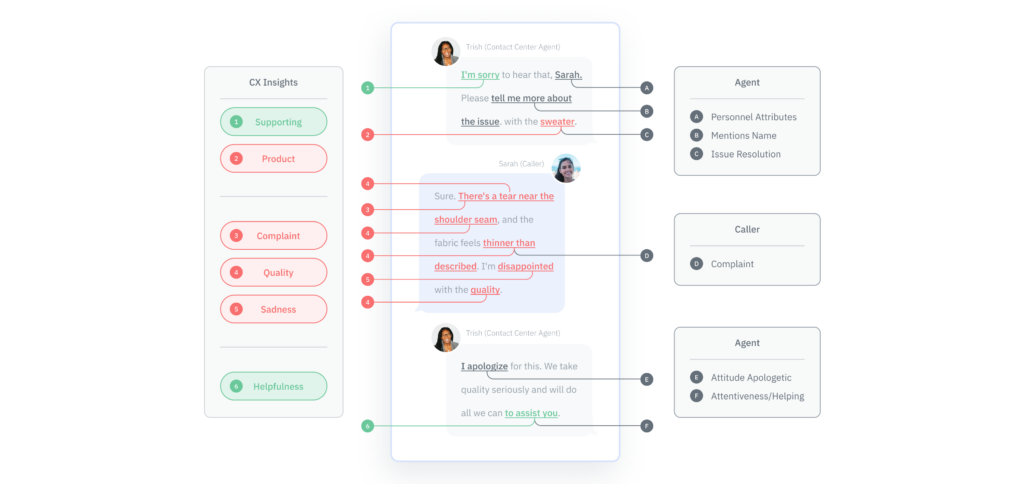Speech Analytics: Turning Conversations into Actionable Insights
Speech analytics encompasses the transformation and analysis of audio recordings into text. This analysis provides businesses with key consumer insights, such as emotional tags and trending complaints. It can be used by businesses to understand the customer experience and make business improvements.
Speech analytics is quickly becoming a foundational aspect of successful experience improvement programs. Historically, it has been difficult to quantify metrics from customer calls. However, the rise of speech analytics has given businesses to understand their customers like never before.
What is Speech Analytics?
Speech analytics is the process of analyzing recorded calls to gather customer information to improve communication and future interaction. It uses advanced technology to transcribe and analyze audio recordings. In doing so, speech analytics gives businesses the ability to uncover insights into customer behavior, sentiment, and preferences. This allows companies to enhance their customer service, marketing strategies, and overall operational efficiency.
What is Contact Center Speech Analytics?
Contact center speech analytics specifically refers to the application of speech analytics technology in a call center environment. Usually working as part of contact center solutions, it involves analyzing the vast volumes of calls handled by contact centers to extract actionable insights from audio recordings.
Contact center speech analytics is useful for businesses looking to improve their contact center performance and overall customer experience. The insights from recorded calls help identify common issues and train agents, which helps improve key customer experience metrics.
By leveraging this technology, contact centers can turn every customer interaction into a valuable data point that drives continuous improvement.
How Does Speech Analytics Work?
Speech analytics combines several advanced technologies to analyze spoken language. The process involves multiple steps:
- Capturing Audio: The first step is recording conversations between customers and agents. These recordings are stored for analysis.
- Automatic Speech Recognition (ASR): ASR technology converts spoken words into text. This is a crucial step as it translates the audio data into a format that can be analyzed.
- Natural Language Processing (NLP): Natural language processing algorithms process the transcribed text to understand the context, sentiment, and meaning behind the words. This involves parsing the text and identifying keywords, phrases, and patterns.
- Machine Learning: Machine learning models analyze the processed text to extract insights. These models can identify trends, detect anomalies, and predict outcomes based on historical data.
- Share Insights: The final step is generating reports and dashboards that present the insights in an easily digestible manner. These insights can be shared with managers, executives, or other stakeholders in order to make informed decisions.
Why is Speech Analytics Important?
Speech analytics is important because it gives you a way of understanding your customers that may not have been previously accessible. A recent study showed that 86% of consumers preferred to talk to a real agent rather than a chatbot or AI-based system regarding customer service inquiries. If you did not have speech analytics software, the only way you would be able to identify common themes and trends is to manually listen to recordings. This is a costly and time-consuming process.
With speech analytics and speech analytics software, you are still able to provide the consumer with the experience they are looking for, while also getting the analysis and data that is important to your business.
What are the Benefits of Speech Analytics?
The benefits of speech analytics extend beyond just sentiment analysis. These tools can help you train employees, develop marketing campaigns, and invest in business improvement that will make an immediate impact. Here are some common benefits of utilizing speech analytics:
Improved Agent Performance
Speech analytics can be a tool to help benchmark agent performance. The insights from speech analytics can help identify the strengths and weaknesses of agents. Businesses can identify best practices to be taught in onboarding and training sessions by analyzing interactions with multiple agents.

Enhanced Customer Understanding
By utilizing speech analytics software, businesses can gain a deeper understanding of their customers by analyzing the context and content of their conversations. They have the ability to view a conversation in its entirety and identify specific emotional tags that arose throughout the course of the case. Identifying these themes will help companies meet customer expectations, which will lead to increased customer satisfaction and loyalty.
Real-time Problem Resolution
With real-time speech analytics, businesses can detect and address issues as they occur during customer interactions. This immediate insight allows supervisors to intervene when necessary, preventing escalation and improving the chances of resolving issues on the first call. Real-time analytics also helps in managing high-stress situations and ensuring that customer concerns are addressed promptly and effectively.
Speech Analytics Uses Cases & Examples
The applications of speech analytics are not limited to one industry or use case. This form of analytics has a wide range of capabilities that can be used from healthcare to e-commerce. The following examples highlight different speech analytics use cases
Speech Analytics in Healthcare
Consider a large healthcare contact center that handles patient inquiries, appointment scheduling, prescription refills, and other services. The nature of this contact center means that they handle thousands of calls daily, and manually listening to the recordings would be an ineffective use of time.
By implementing speech analytics software, all incoming and outgoing calls can be recorded and stored securely in compliance with HIPAA regulations. These calls are transcribed into text, analyzed, and categorized by common tags such as calls related to appointments, billing, or prescription refills.
After the calls are categorized, the trends can be analyzed. Perhaps this call center notices that over the last 90 days, there has been an increase in calls related to long wait times. These insights are shared with hospital management, which may result in an increase in staffing during certain hours to decrease wait times. By utilizing speech analytics, this healthcare organization was able to increase patient satisfaction.
Speech Analytics in E-Commerce
Imagine an e-commerce company that operates an omnichannel contact center. This contact center handles customer inquiries across multiple channels such as phone, email, online chat, and even review management. This contact center may already have a text analytics solution in place to tag and categorize customer feedback in the form of text data. However, being unable to effectively tag customer calls, these are left out of the data. This leads to an incomplete picture of the e-commerce customer experience.
By implementing speech analytics, customer calls can be recorded in a way that allows them to be added to the rest of the contact center customer data. This provides the business with a complete view of its customer experience and helps identify areas of improvement.
What is Next For Speech Analytics?
While speech analytics is not necessarily in its infancy, it has been no stranger to increased growth. The future of speech analytics is closely tied to advancements in AI and machine learning. These AI algorithms will enable better detection of emotions and sentiments. You can expect speech analytics to improve in two major ways in the coming future:
AI Speech Analytics
AI speech analytics can be used as another way to describe the current capabilities of speech analytics because of the use of machine learning. However, AI speech analytics will continue to grow by going beyond just categorizing audio recordings. After identifying different emotional tags and trends, AI speech analytics will be able to quickly summarize the findings and offer immediate areas for improvement. This, as opposed to presenting the data and requiring human input, will make the end-to-end process of speech analytics quicker.
Of course, as these capabilities grow, there will be errors, and all important data and decisions should be human-reviewed. That being said, the continued growth of speech analytics will most likely result in the further optimization and improvement of businesses.
Holistic Analytics
Holistic analytics represents the combination of speech analytics, text analytics, and video analytics. Putting these solutions together will make it easier for organizations to understand their customers, regardless of the channel they choose to communicate with them from. Also, as a packaged deal, it will be more cost-effective and most likely provide a better return on investment.
What to Look For in Speech Analytics Software
Not all speech analytics software comes with the same features. The features that are the most important will depend on the specific goals of your business. However, there are certain features that should be must-haves when looking for a speech analytics solution.
Diverse Analysis Capabilities
While some businesses may settle for a speech analytics solution that is limited to only analyzing the customer during the call. Advanced speech analytics solutions will have a wide range of analysis capabilities that are able to analyze customer emotions as well as how the agent is responding to the customer and how the two parties interact. By analyzing the conversation in its entirety, you gain access to a more complete analysis.

Integration Capabilities
It is important to choose a solution that supports a wide range of integrations, such as integrating into your contact center analytics software. Being able to implement speech analytics software that works alongside your current systems will increase the adoption rate within the organization and get the most out of the software as soon as possible.
Support
It is important to choose speech analytics software that comes with a dedicated support team. This is important because having expert support ensures that any issues or challenges are promptly addressed.
Best Practices for Implementing Speech Analytics Software
In order to complete a smooth implementation of speech analytics software, it is best to have a plan. Having an implementation plan will make sure the organization can succeed with the software, and get all appropriate staff involved in the right order.
1. Define Objectives
By defining your objectives, you clearly outline what you are aiming to achieve. This will help you stay focused and avoid any distractions that come up in the early stages of adoption. For example, you may be tempted to set up a feature you did not fully understand in the demo. But, doing so wouldn’t allow your team to use the core functionalities they need. By having a goal, you can make sure your team has what they need as soon as possible.
2. Integrate with Existing Systems
During the implementation process, it is vital to ensure that the software works well within your current technology stack. If there is an issue, contact your support team as soon as possible to try and get the issue resolved.
3. Train Employees
As soon as the software is accessible to all employees, provide comprehensive training on how to use the software and interpret its insights. This step is crucial to the adoption across the company. Avoiding this will cause employees to make mistakes, which may take more time to resolve.
4. Monitor
After the initial implementation push is over, monitoring the chosen software is important to its continued success. As it becomes a more integral part of your business processes, certain discrepancies may arise that need to be addressed. Conversely, all early successes with the software need to be highlighted so they can be recreated in the future.
Choose Pearl-Plaza as Your Speech Analytics Solution
Pearl-Plaza’s conversation analytics software allows your business to have access to state-of-the-art speech analytics software, as well as other capabilities such as AI summarization, agent and coach scorecards, and more! See what Pearl-Plaza can do for you by scheduling a demo today.
References
CGS. CGS Survey Reveals Consumers Prefer a Hybrid AI/Human Approach to Customer Service. Is there Chatbot Fatigue? (https://www.cgsinc.com/en/resources/2019-cgs-customer-service-chatbots-channels-survey). Accessed 6/27/2024.

REPORT
Pearl-Plaza Named a Leader in The Forrester Wave™: Text Mining And Analytics Platforms, Q2 2024
Learn how Pearl-Plaza is pioneering innovative solutions for businesses to extract insights and drive meaningful change from their unstructured text data.




